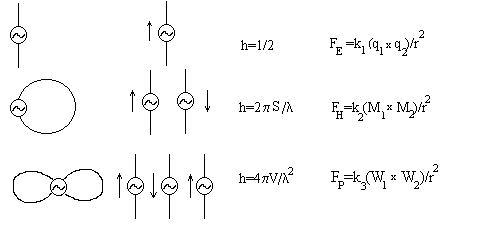
here h is operating length,
V is volume,
l is length,
S is square,
M is magnetic charge,
l is wavelength,
q is electric charge,
W is bulk of energy.
This engine is based on the pondemotor effect that is the principle of creation of propulsion force after interaction between electric and magnetic fields. The interaction between electric and magnetic fields produces energy-flux, determined by the Poynting vector [1,2]:
Peculiarities of Poynting's vector are:
1. Violation of the principle of composition of fields:
3. Poynting's vector is constant for circular polarized electromagnetic field:
Let's consider three types of interaction - electric, magnetic and gravitational - on one point of view. It allow us to draw an analogy between gravitational field and Poynting's vector.

here h is operating length,
V is volume,
l is length,
S is square,
M is magnetic charge,
l
is wavelength,
q is electric charge,
W is bulk of energy.
Electric exciting of the space is initial (primary) one. It has flat
polarization and maximum interaction with free space. A magnetic exciter is
produced after closing the electric exciter to itself or a couple of parallel
electric exciters with opposite feed.
A composition on three electric
exciters or two magnetic exciters with opposite feed can be a gravitational
exciters. In the last case, the exciter is polarized in volume and it in some
possible case it can be the rotation of volume to form the toroid.
In
first case the space is excited by electric and magnetic fields. In second case,
only magnetic field excites the space. In third case both electric and magnetic
fields close themselves and electromagnetic energy concentrates in volume. Only
Poynting's vector comes inside and it defines the energetic condition of volume.
The main interest for engine is the circular polarization of magnetic
field. In a wave zone either two equal components of the field these are 90
degrees phase shifted, or electromagnetic dipole give us the circular
polarization [3]. The electromagnetic dipole at the first half of the period
creates electric field, the next half of the period it creates the magnetic
field, that correspond to 90 degrees phase shift.
We are interested in
zone nearby the exciter because force of pondemotor action is placed here. In
contrast to wave zone, the electric component has not sinphase magnetic
component and the magnetic component has not sinphase electric component here.
The sinphase components have not formed yet here. Then we offer to make these
components artificially, as so to excite the space with two crossed
electromagnetic dipoles, those are fed with 90 degrees phase shift.
There are a lot of versions for exciters disposition and feed, and in
particular case it is radial and circular dispositions, those are corresponding
to feed and step h=2p/N (the analogy of feed to
form the triangle and star).
Assuming the ether excitance we can use
its properties for evidence. It allows us to draw an analogy with movement of
liquid or gas with absolutely resilient properties and to deal with moving ether
under the action of electromagnetic field. Then we can say that electric and
magnetic fields act on the ether with force F=P/c, forcing the ether to
move. But the energy-flux that is produced by alone fragment of the exciter,
compensates the incoming and out coming quantity of ether. We must make some
asymmetrical construction for discompensation of these fluxes. the second
fragment of the exciter will provide the second pair of forces with different
geometry, different operation frequency and different direction of rotation. For
example, if we take two fragments with different diameters these are disposed at
a distance h from each other, but with equal P, and disposite them coaxial
then the ether will moves asymmetrically in strength of the law of conservation
of the quantity of the motion, and the result for it is the propulsion force Ft.
At the present time a third model of the fragment of the engine is
built (Fig.1) and its main technical parameters are measured. So, on the
frequency at 80 kHz :
the electric intensity
E=105 V/m,
the total electric intensity
E=106 V/m,
the magnetic intensity H=2 x
104 A/m,
the Poynting's vector
P=1010 Joule/(m2 x s)
the propulsion force
F=60 N
with input power to one arm at 10 kW.
In the near future we'll start estimating experiments of engine fragment pondemotor effect above the Earth surface: rotation moment, interaction between the exciter and its mirror reflection from the Earth surface and so on. We have started to design a life-size fragment of the engine with radius R=40 m, which will create P=1014Joule/(m2 x s) and Ft=3 x104 N.
1. I.Tamm, The bases of the electric theory, Moscow, Leningrad, 1949.
2.
N.Kalashnikov, G.Phrantov, V.Gordienko. The bases of the theory of
electromagnetic dipole and possibility of its using in electroprospecting. Lvov,
1977.
3. The pondemotor act of electromagnetic field, edited by R.VAlitov,
Moscow, 1975.